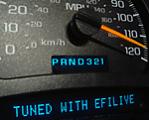Ok guys, you may want to grab a cold one before you start reading this.
Several months back, Michael Patton aka Killerbee started a discussion on idle timing for the LLY in this thread:
http://forum.efilive.com/showthread.php?t=9692
He emphasized how much fuel is wasted at idle with stock timing. Well, my city mileage is pretty poor and of course in Las Vegas we run the A/C all the time which probably consumes more fuel, so I started looking at changing the idle timing on my LBZ. For the LBZ, we have table B0909, injection timing table B, which apparently serves as base timing down to 300 rpm. 300 rpm is probably for starting, so I only wanted to mess with the 600 and 800 rpm columns.
My first thought was to try the 50/50 rule, where you have 50% of the injection before TDC and 50% after. The famous spreadsheet available on TheDieselPlace.com to calculate this doesn't go below 1400 rpm, so I planned on manually calculating the numbers for 600 and 800 rpm and changing table B0909 accordingly.
First, I looked at B1001, which is fuel pressure for rpm vs. injection quantity, and could see that for idle speeds and typical fuel quantities, the fuel pressure is 30 to 35 MPa. Then looking at table B0720 in the 30 MPa column gives you the microseconds (us) of injection time for the given fuel quantities. Obviously you need the injection time to calculate how many degrees before TDC the injection has to start to give you the 50/50 pulse. However, here is where the problem comes in. In the 30MPa column, you can see that to get 0.1 mm3 of fuel takes 369 us of injection time. But to get 10 times that much fuel, i.e., 1 mm3, takes 382 us, only 13 us longer. So it must be that most of the time is used up just opening and closing the injector. Looking further, to get 10 times THAT much fuel, i.e., 10mm3, takes 615 us, or 233 us longer. Taking the injector reaction time (IRT) out of it, I can't explain why the time-to-deliver verses quantity of fuel is not linear for a constant pressure, but maybe somebody versed in fluid dynamics can.
My point is that, for low fuel quantities, the IRT seems to be significant. Just eyeballing B0720, I think the IRT is around 360 us. If that's true, then the actual injection time for a 1 mm3 pulse of fuel is about 22 us. At 800 rpm, 360 us is about 1.73* of crankshaft rotation, 22 us is only about 0.11*. The standard thinking is that you need a value of (1.73 + .11)/2 or 0.92* BTDC injection timing to get the 50/50 pulse split. I guess that is still true if the actual injection spray occurs in the middle of the 360 us, but I don't think it does. If you consider that the spray goes on until the injector is closed, then the spray probably ends at the end of the 382 us time period. So, if you set your injection timing at .92* BTDC, the actual injection, or the spray, starts at around .81* ATDC, still a very retarded setting.
The only other aspect I can think of right now is that as the injection quantity increases, the injector reacttion time becomes less significant, but as the rpm increases, it becomes more significant again. For example, at 2000 rpm, the 360 us is about 4.3* of crankshaft rotation.
So what do you guys think? Am I way out in left field here? Does any of this matter? Am I too obsessive/compulsive? How do you guys set your timing? Should I just increase it until it sounds funny and then back it off a little? I'm throwing this out there for discussion.



 Reply With Quote
Reply With Quote





 Tuning by ME
Tuning by ME
